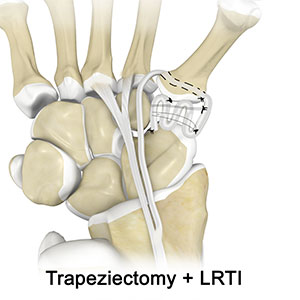
What is Trapeziectomy?
Trapeziectomy is a surgical procedure to treat a medical condition called thumb carpometacarpal joint arthritis. The procedure involves removal of a small, cube-shaped bone known as the trapezium at the base of the thumb joint which joins your thumb to your wrist.
Why is Trapeziectomy Done?
The primary reason to undergo trapeziectomy is to resolve pain at the base of the thumb that becomes worse with movement or activity (e.g., turning a key, opening a door or jar lid, lifting a cup, peeling vegetables, combing hair, etc.). The pain may be felt even during inactivity or rest and result in deformity at the base of the thumb.
Other indications for trapeziectomy can be:
- Tenderness, swelling, and stiffness at the base of the thumb.
- A thumb that appears crooked with limited range of motion.
- Difficulty in gripping or grasping objects or in pinching.
- Feeling of a crunchy sound at the thumb base with certain movements.
What are the Benefits of the Procedure?
Trapeziectomy improves how your thumb functions. Added benefits of the procedure include:
- More space for thumb movement and thus less pain.
- Better grip or grasp and pinch strength.
- Increased mobility and flexibility of the thumb.
How is the Procedure Performed?
During the procedure, the surgeon is likely to:
- Make an incision in the back of the hand at the base of your thumb
- Remove the trapezium
- Reconstruct a ligament at the base of the thumb using an extra tendon from the forearm
- Insert a folded piece of tendon in the empty space previously occupied by the trapezium
- Close the joint lining and then close your skin
- Apply a dressing and splint to the operated spot to protect your thumb
What are the Risks Associated with Trapeziectomy?
Potential risks or complications associated with trapeziectomy are:
- Continued pain, swelling, stiffness or weakness in the hand.
- Nerve damage and numbness along the side of your thumb.
- Unsightly scarring with tenderness or bleeding or infection.
What Precautions should be Taken as You Recover from Trapeziectomy?
Keep your splint clean and dry after surgery. Approximately 2 weeks after surgery, your initial splint will be replaced with a removable splint.
This should always be worn and removed only during hand washing and while performing the exercises recommended by the surgeon. You will be advised not to alter the splint yourself or leave your splint near a heat source. Exercises should be performed slowly to make sure they do not cause too much discomfort.
As you recover, you are expected to:
- Keep the dressing clean and dry.
- Keep your hand elevated for at least 48 hours after the surgery.
- Avoid dangling your hands by your side when you walk.
- Rest your hand on a pillow or cushion instead of your lap when you sit.
- Report any signs of wound infection, such as redness or pus to your surgeon.
Recovery to full function may take 6 months or so.
Related Topics
- Osteotomy for Distal Radius Malunion
- Wrist Open Reduction and Internal Fixation
- ORIF of Distal Radius Fracture
- Trapeziectomy
- Peripheral Nerve Repair
- Wrist Arthroscopy
- Microvascular Surgery
- Wrist Joint Replacement
- Carpal Tunnel Release Surgery
- Wrist Ligament Reconstruction
- Total Wrist Arthrodesis
- Hand Fracture Surgery
- ORIF of the Forearm Fractures
- Endoscopic Carpal Tunnel Surgery
- Wrist Fracture Fixation
- Sports Injury Management of Hand, Wrist and Elbow





